Analysis of Low Impact Manufacturing Processes for Biscuit Production
VerifiedAdded on 2023/01/12
|6
|1335
|86
Report
AI Summary
This report provides an in-depth analysis of low impact manufacturing processes within the context of biscuit production. It begins by outlining three key processes: dough making and mixing, fermentation, and cooling and testing. The study then utilizes a Sankey diagram to illustrate energy flows, conversions, and losses during the biscuit baking process, including optimal temperature ranges for yeast activity. Furthermore, the report explores the application of renewable energy technologies, specifically focusing on the PRISM oven and bioenergy, highlighting their potential to enhance consistency, improve ecological balance, and reduce the environmental impact of biscuit manufacturing. The conclusion summarizes the key findings, emphasizing the importance of sustainable practices in the industry.

Low Impact Manufacturing
Paraphrase This Document
Need a fresh take? Get an instant paraphrase of this document with our AI Paraphraser
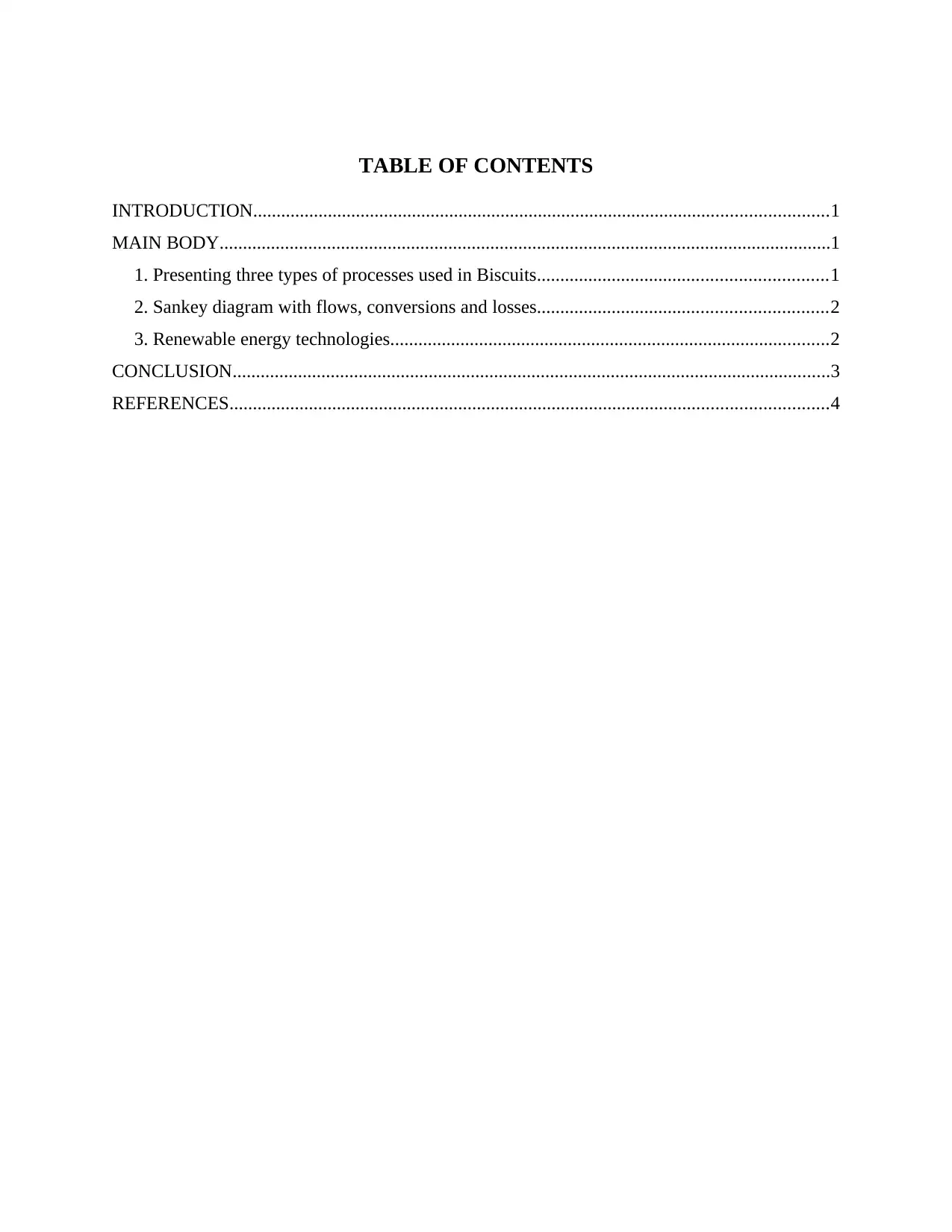
TABLE OF CONTENTS
INTRODUCTION...........................................................................................................................1
MAIN BODY...................................................................................................................................1
1. Presenting three types of processes used in Biscuits..............................................................1
2. Sankey diagram with flows, conversions and losses..............................................................2
3. Renewable energy technologies..............................................................................................2
CONCLUSION................................................................................................................................3
REFERENCES................................................................................................................................4
INTRODUCTION...........................................................................................................................1
MAIN BODY...................................................................................................................................1
1. Presenting three types of processes used in Biscuits..............................................................1
2. Sankey diagram with flows, conversions and losses..............................................................2
3. Renewable energy technologies..............................................................................................2
CONCLUSION................................................................................................................................3
REFERENCES................................................................................................................................4
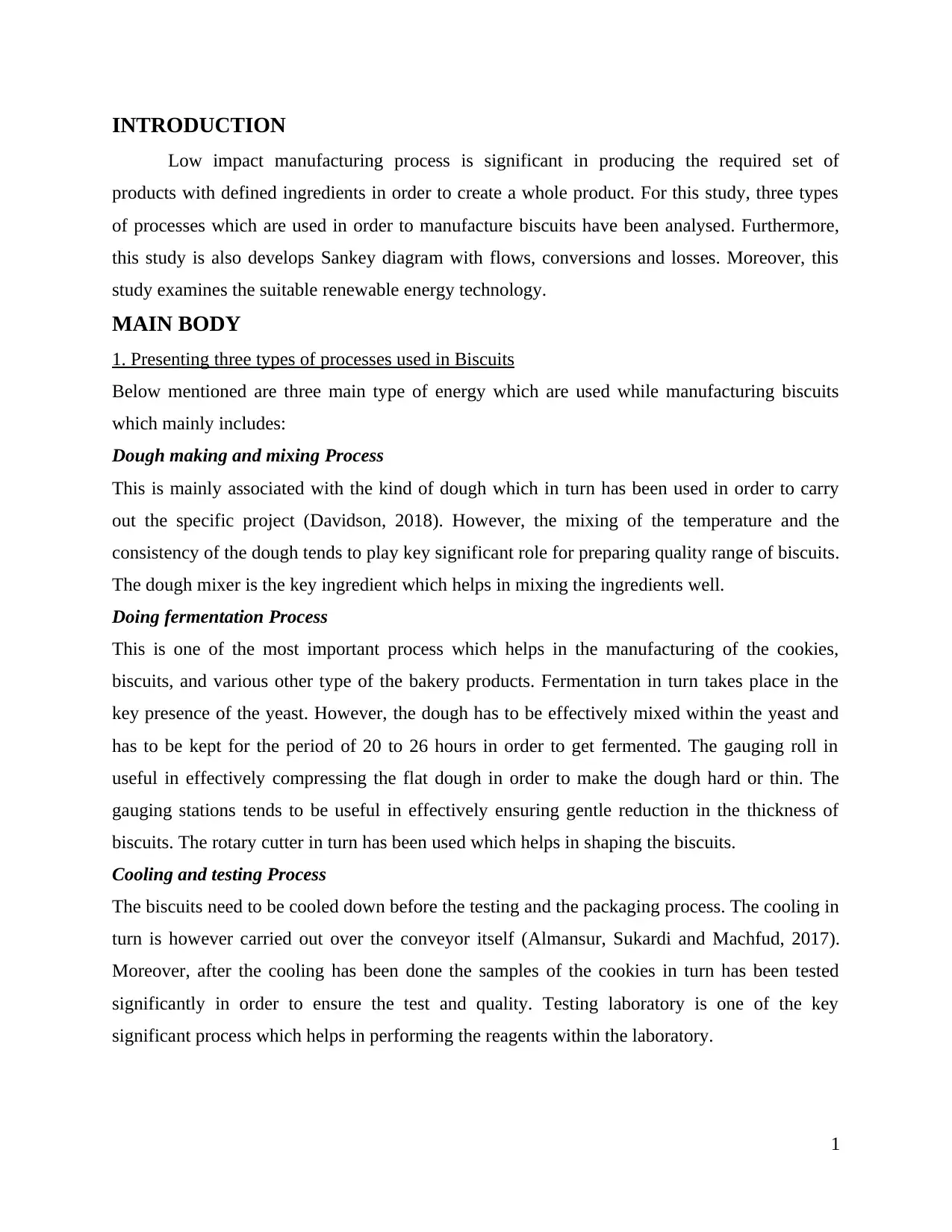
INTRODUCTION
Low impact manufacturing process is significant in producing the required set of
products with defined ingredients in order to create a whole product. For this study, three types
of processes which are used in order to manufacture biscuits have been analysed. Furthermore,
this study is also develops Sankey diagram with flows, conversions and losses. Moreover, this
study examines the suitable renewable energy technology.
MAIN BODY
1. Presenting three types of processes used in Biscuits
Below mentioned are three main type of energy which are used while manufacturing biscuits
which mainly includes:
Dough making and mixing Process
This is mainly associated with the kind of dough which in turn has been used in order to carry
out the specific project (Davidson, 2018). However, the mixing of the temperature and the
consistency of the dough tends to play key significant role for preparing quality range of biscuits.
The dough mixer is the key ingredient which helps in mixing the ingredients well.
Doing fermentation Process
This is one of the most important process which helps in the manufacturing of the cookies,
biscuits, and various other type of the bakery products. Fermentation in turn takes place in the
key presence of the yeast. However, the dough has to be effectively mixed within the yeast and
has to be kept for the period of 20 to 26 hours in order to get fermented. The gauging roll in
useful in effectively compressing the flat dough in order to make the dough hard or thin. The
gauging stations tends to be useful in effectively ensuring gentle reduction in the thickness of
biscuits. The rotary cutter in turn has been used which helps in shaping the biscuits.
Cooling and testing Process
The biscuits need to be cooled down before the testing and the packaging process. The cooling in
turn is however carried out over the conveyor itself (Almansur, Sukardi and Machfud, 2017).
Moreover, after the cooling has been done the samples of the cookies in turn has been tested
significantly in order to ensure the test and quality. Testing laboratory is one of the key
significant process which helps in performing the reagents within the laboratory.
1
Low impact manufacturing process is significant in producing the required set of
products with defined ingredients in order to create a whole product. For this study, three types
of processes which are used in order to manufacture biscuits have been analysed. Furthermore,
this study is also develops Sankey diagram with flows, conversions and losses. Moreover, this
study examines the suitable renewable energy technology.
MAIN BODY
1. Presenting three types of processes used in Biscuits
Below mentioned are three main type of energy which are used while manufacturing biscuits
which mainly includes:
Dough making and mixing Process
This is mainly associated with the kind of dough which in turn has been used in order to carry
out the specific project (Davidson, 2018). However, the mixing of the temperature and the
consistency of the dough tends to play key significant role for preparing quality range of biscuits.
The dough mixer is the key ingredient which helps in mixing the ingredients well.
Doing fermentation Process
This is one of the most important process which helps in the manufacturing of the cookies,
biscuits, and various other type of the bakery products. Fermentation in turn takes place in the
key presence of the yeast. However, the dough has to be effectively mixed within the yeast and
has to be kept for the period of 20 to 26 hours in order to get fermented. The gauging roll in
useful in effectively compressing the flat dough in order to make the dough hard or thin. The
gauging stations tends to be useful in effectively ensuring gentle reduction in the thickness of
biscuits. The rotary cutter in turn has been used which helps in shaping the biscuits.
Cooling and testing Process
The biscuits need to be cooled down before the testing and the packaging process. The cooling in
turn is however carried out over the conveyor itself (Almansur, Sukardi and Machfud, 2017).
Moreover, after the cooling has been done the samples of the cookies in turn has been tested
significantly in order to ensure the test and quality. Testing laboratory is one of the key
significant process which helps in performing the reagents within the laboratory.
1
⊘ This is a preview!⊘
Do you want full access?
Subscribe today to unlock all pages.

Trusted by 1+ million students worldwide
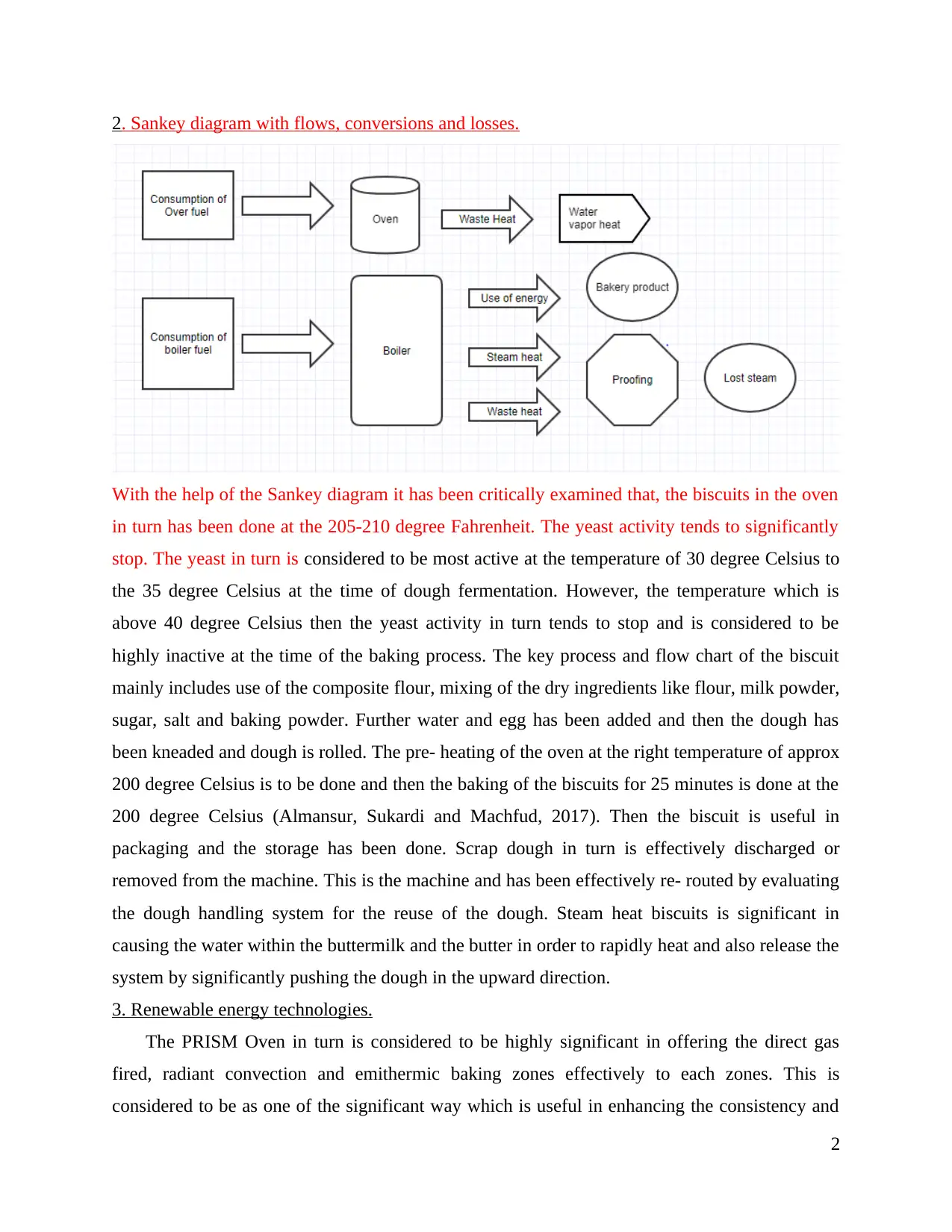
2. Sankey diagram with flows, conversions and losses.
With the help of the Sankey diagram it has been critically examined that, the biscuits in the oven
in turn has been done at the 205-210 degree Fahrenheit. The yeast activity tends to significantly
stop. The yeast in turn is considered to be most active at the temperature of 30 degree Celsius to
the 35 degree Celsius at the time of dough fermentation. However, the temperature which is
above 40 degree Celsius then the yeast activity in turn tends to stop and is considered to be
highly inactive at the time of the baking process. The key process and flow chart of the biscuit
mainly includes use of the composite flour, mixing of the dry ingredients like flour, milk powder,
sugar, salt and baking powder. Further water and egg has been added and then the dough has
been kneaded and dough is rolled. The pre- heating of the oven at the right temperature of approx
200 degree Celsius is to be done and then the baking of the biscuits for 25 minutes is done at the
200 degree Celsius (Almansur, Sukardi and Machfud, 2017). Then the biscuit is useful in
packaging and the storage has been done. Scrap dough in turn is effectively discharged or
removed from the machine. This is the machine and has been effectively re- routed by evaluating
the dough handling system for the reuse of the dough. Steam heat biscuits is significant in
causing the water within the buttermilk and the butter in order to rapidly heat and also release the
system by significantly pushing the dough in the upward direction.
3. Renewable energy technologies.
The PRISM Oven in turn is considered to be highly significant in offering the direct gas
fired, radiant convection and emithermic baking zones effectively to each zones. This is
considered to be as one of the significant way which is useful in enhancing the consistency and
2
With the help of the Sankey diagram it has been critically examined that, the biscuits in the oven
in turn has been done at the 205-210 degree Fahrenheit. The yeast activity tends to significantly
stop. The yeast in turn is considered to be most active at the temperature of 30 degree Celsius to
the 35 degree Celsius at the time of dough fermentation. However, the temperature which is
above 40 degree Celsius then the yeast activity in turn tends to stop and is considered to be
highly inactive at the time of the baking process. The key process and flow chart of the biscuit
mainly includes use of the composite flour, mixing of the dry ingredients like flour, milk powder,
sugar, salt and baking powder. Further water and egg has been added and then the dough has
been kneaded and dough is rolled. The pre- heating of the oven at the right temperature of approx
200 degree Celsius is to be done and then the baking of the biscuits for 25 minutes is done at the
200 degree Celsius (Almansur, Sukardi and Machfud, 2017). Then the biscuit is useful in
packaging and the storage has been done. Scrap dough in turn is effectively discharged or
removed from the machine. This is the machine and has been effectively re- routed by evaluating
the dough handling system for the reuse of the dough. Steam heat biscuits is significant in
causing the water within the buttermilk and the butter in order to rapidly heat and also release the
system by significantly pushing the dough in the upward direction.
3. Renewable energy technologies.
The PRISM Oven in turn is considered to be highly significant in offering the direct gas
fired, radiant convection and emithermic baking zones effectively to each zones. This is
considered to be as one of the significant way which is useful in enhancing the consistency and
2
Paraphrase This Document
Need a fresh take? Get an instant paraphrase of this document with our AI Paraphraser
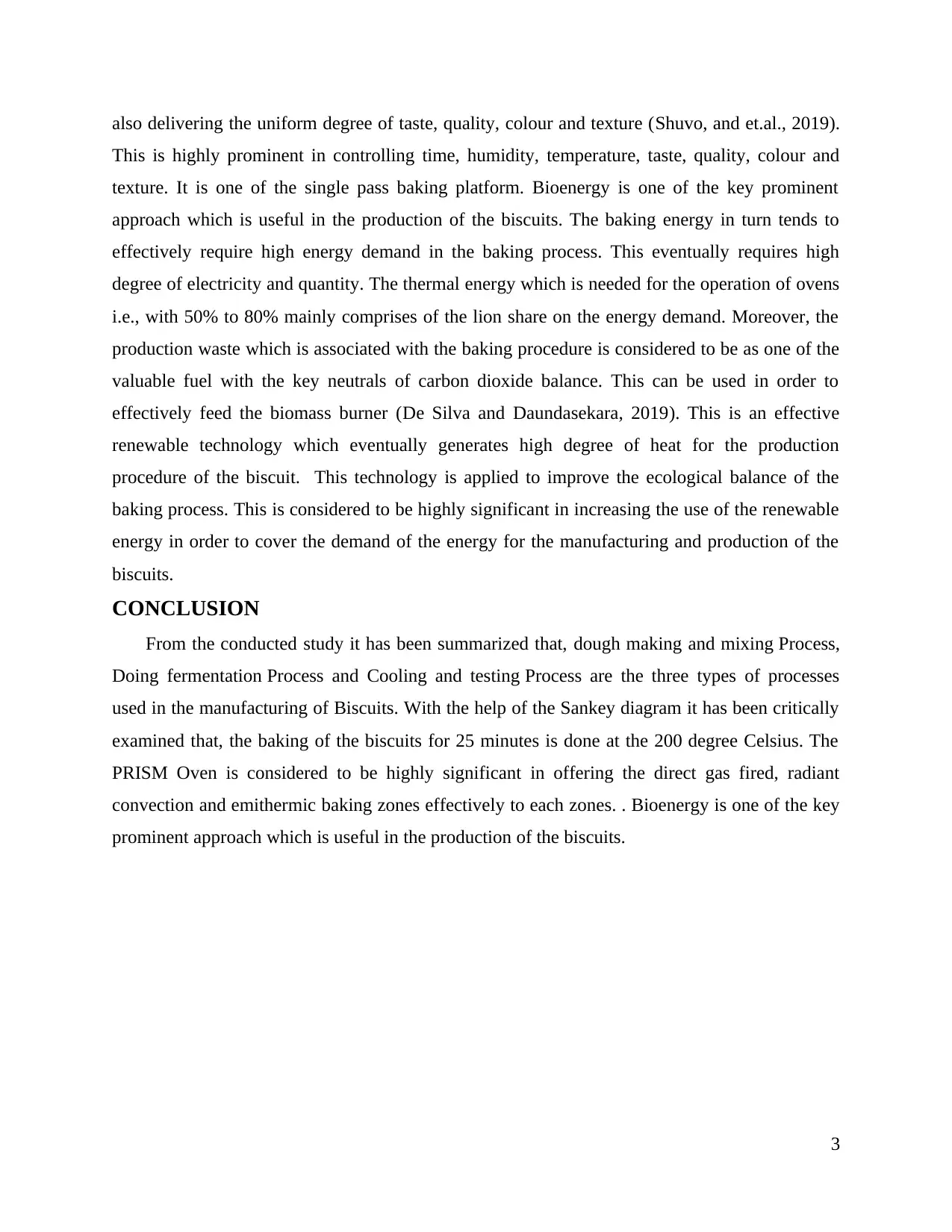
also delivering the uniform degree of taste, quality, colour and texture (Shuvo, and et.al., 2019).
This is highly prominent in controlling time, humidity, temperature, taste, quality, colour and
texture. It is one of the single pass baking platform. Bioenergy is one of the key prominent
approach which is useful in the production of the biscuits. The baking energy in turn tends to
effectively require high energy demand in the baking process. This eventually requires high
degree of electricity and quantity. The thermal energy which is needed for the operation of ovens
i.e., with 50% to 80% mainly comprises of the lion share on the energy demand. Moreover, the
production waste which is associated with the baking procedure is considered to be as one of the
valuable fuel with the key neutrals of carbon dioxide balance. This can be used in order to
effectively feed the biomass burner (De Silva and Daundasekara, 2019). This is an effective
renewable technology which eventually generates high degree of heat for the production
procedure of the biscuit. This technology is applied to improve the ecological balance of the
baking process. This is considered to be highly significant in increasing the use of the renewable
energy in order to cover the demand of the energy for the manufacturing and production of the
biscuits.
CONCLUSION
From the conducted study it has been summarized that, dough making and mixing Process,
Doing fermentation Process and Cooling and testing Process are the three types of processes
used in the manufacturing of Biscuits. With the help of the Sankey diagram it has been critically
examined that, the baking of the biscuits for 25 minutes is done at the 200 degree Celsius. The
PRISM Oven is considered to be highly significant in offering the direct gas fired, radiant
convection and emithermic baking zones effectively to each zones. . Bioenergy is one of the key
prominent approach which is useful in the production of the biscuits.
3
This is highly prominent in controlling time, humidity, temperature, taste, quality, colour and
texture. It is one of the single pass baking platform. Bioenergy is one of the key prominent
approach which is useful in the production of the biscuits. The baking energy in turn tends to
effectively require high energy demand in the baking process. This eventually requires high
degree of electricity and quantity. The thermal energy which is needed for the operation of ovens
i.e., with 50% to 80% mainly comprises of the lion share on the energy demand. Moreover, the
production waste which is associated with the baking procedure is considered to be as one of the
valuable fuel with the key neutrals of carbon dioxide balance. This can be used in order to
effectively feed the biomass burner (De Silva and Daundasekara, 2019). This is an effective
renewable technology which eventually generates high degree of heat for the production
procedure of the biscuit. This technology is applied to improve the ecological balance of the
baking process. This is considered to be highly significant in increasing the use of the renewable
energy in order to cover the demand of the energy for the manufacturing and production of the
biscuits.
CONCLUSION
From the conducted study it has been summarized that, dough making and mixing Process,
Doing fermentation Process and Cooling and testing Process are the three types of processes
used in the manufacturing of Biscuits. With the help of the Sankey diagram it has been critically
examined that, the baking of the biscuits for 25 minutes is done at the 200 degree Celsius. The
PRISM Oven is considered to be highly significant in offering the direct gas fired, radiant
convection and emithermic baking zones effectively to each zones. . Bioenergy is one of the key
prominent approach which is useful in the production of the biscuits.
3
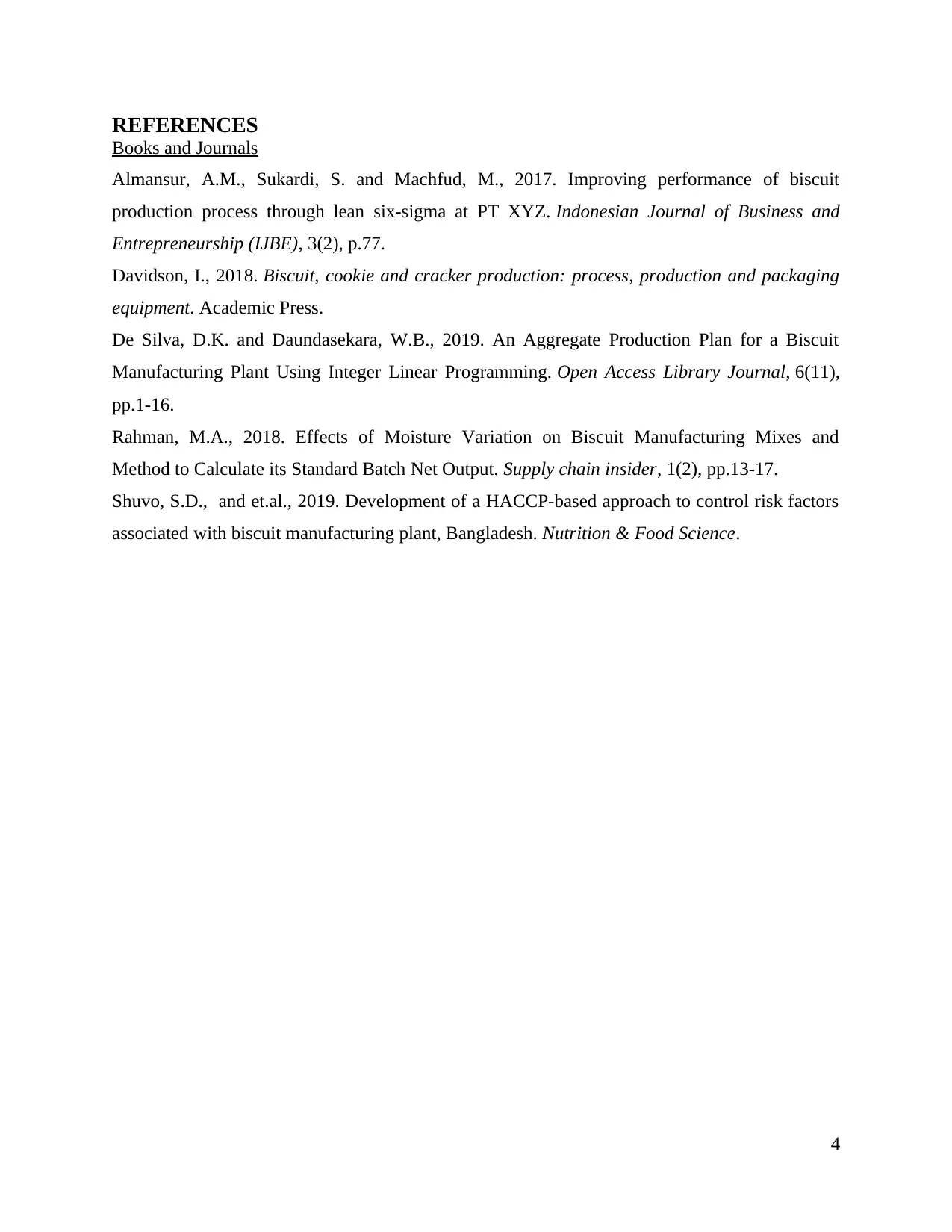
REFERENCES
Books and Journals
Almansur, A.M., Sukardi, S. and Machfud, M., 2017. Improving performance of biscuit
production process through lean six-sigma at PT XYZ. Indonesian Journal of Business and
Entrepreneurship (IJBE), 3(2), p.77.
Davidson, I., 2018. Biscuit, cookie and cracker production: process, production and packaging
equipment. Academic Press.
De Silva, D.K. and Daundasekara, W.B., 2019. An Aggregate Production Plan for a Biscuit
Manufacturing Plant Using Integer Linear Programming. Open Access Library Journal, 6(11),
pp.1-16.
Rahman, M.A., 2018. Effects of Moisture Variation on Biscuit Manufacturing Mixes and
Method to Calculate its Standard Batch Net Output. Supply chain insider, 1(2), pp.13-17.
Shuvo, S.D., and et.al., 2019. Development of a HACCP-based approach to control risk factors
associated with biscuit manufacturing plant, Bangladesh. Nutrition & Food Science.
4
Books and Journals
Almansur, A.M., Sukardi, S. and Machfud, M., 2017. Improving performance of biscuit
production process through lean six-sigma at PT XYZ. Indonesian Journal of Business and
Entrepreneurship (IJBE), 3(2), p.77.
Davidson, I., 2018. Biscuit, cookie and cracker production: process, production and packaging
equipment. Academic Press.
De Silva, D.K. and Daundasekara, W.B., 2019. An Aggregate Production Plan for a Biscuit
Manufacturing Plant Using Integer Linear Programming. Open Access Library Journal, 6(11),
pp.1-16.
Rahman, M.A., 2018. Effects of Moisture Variation on Biscuit Manufacturing Mixes and
Method to Calculate its Standard Batch Net Output. Supply chain insider, 1(2), pp.13-17.
Shuvo, S.D., and et.al., 2019. Development of a HACCP-based approach to control risk factors
associated with biscuit manufacturing plant, Bangladesh. Nutrition & Food Science.
4
⊘ This is a preview!⊘
Do you want full access?
Subscribe today to unlock all pages.

Trusted by 1+ million students worldwide
1 out of 6
Related Documents
Your All-in-One AI-Powered Toolkit for Academic Success.
+13062052269
info@desklib.com
Available 24*7 on WhatsApp / Email
![[object Object]](/_next/static/media/star-bottom.7253800d.svg)
Unlock your academic potential
Copyright © 2020–2025 A2Z Services. All Rights Reserved. Developed and managed by ZUCOL.



